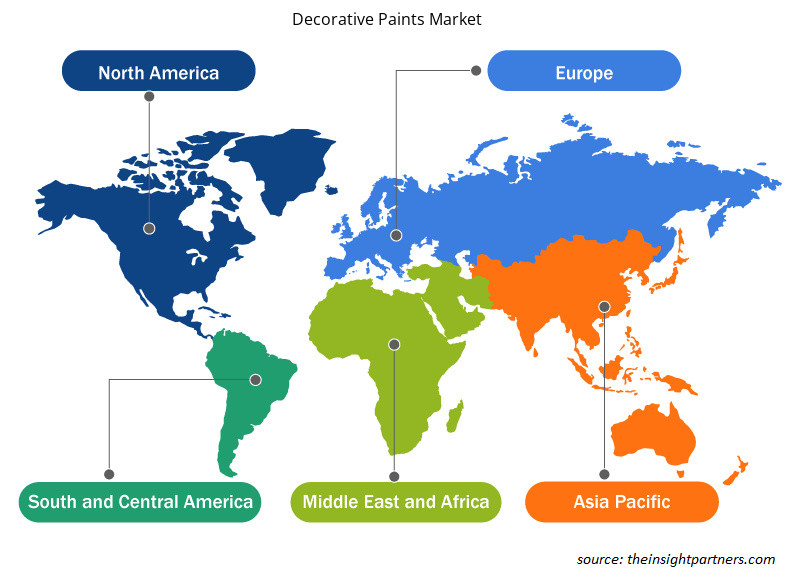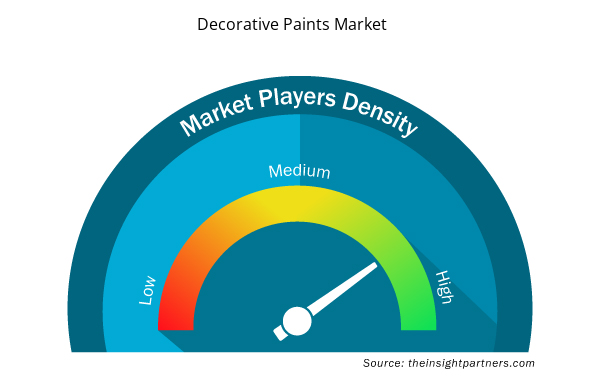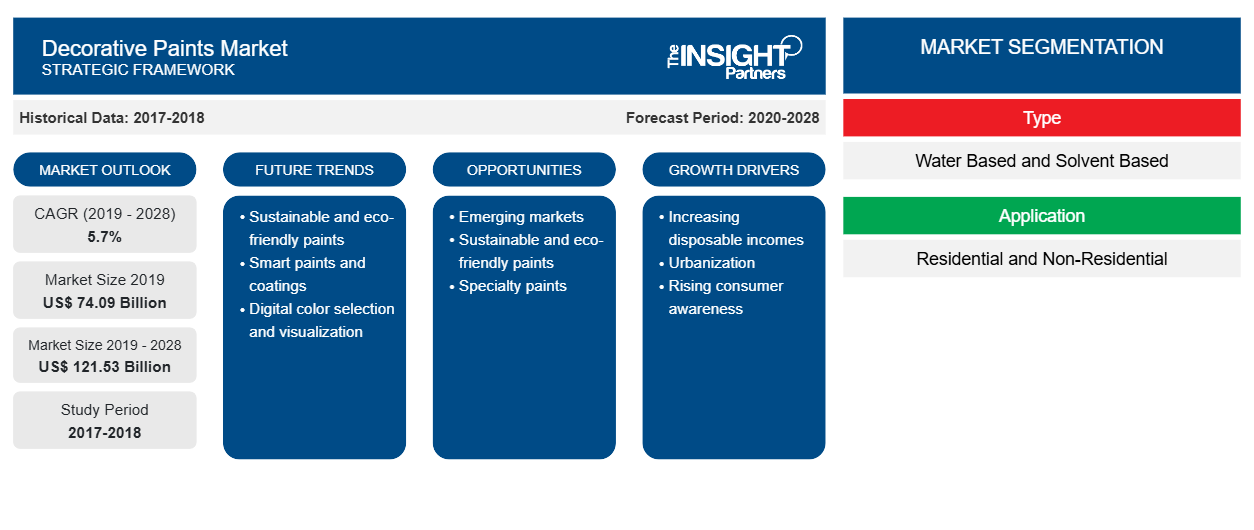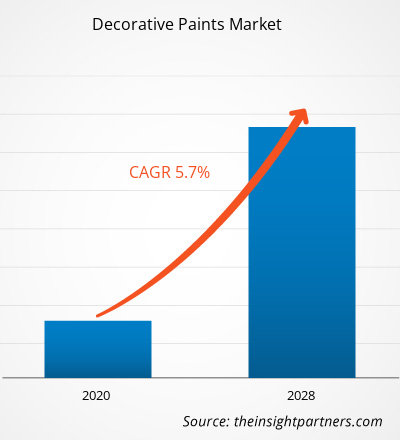2019 年装饰涂料市场价值为 740.9154 亿美元,预计到 2028 年将达到 1215.3191 亿美元;预计 2020 年至 2028 年的复合年增长率为 5.7%。
装饰涂料是指丙烯酸涂料,有助于在室内外应用中赋予美观的设计和独特的纹理。由于消费者生活模式的变化以及对家庭、办公室、综合体和其他此类空间外观的日益关注,对装饰涂料的需求正在上升。随着涂料行业的发展,装饰涂料在基础设施和建筑领域的应用已得到认可,因为它们有助于美化建筑物的外部和内部空间。此类涂料具有哑光、蛋壳色、光泽或缎面等多种效果,有助于提供独特的艺术品。此外,装饰涂料还以其多种功能特性而闻名,例如光吸收和反射、隔热和低挥发性有机化合物排放。
预计欧洲装饰涂料市场在预测期内将以最高速度增长。由于投资增加和经济复苏,基础设施项目数量增加,推动了该地区对装饰涂料的需求。建筑实践和路面设计大多需要高质量的材料来满足各种基础设施标准。新中产阶级对更好生活水平的需求不断增加,对装饰涂料的采用产生了积极影响。西欧消费和生产的建筑涂料几乎全部是中高档产品,因为消费者对家居装饰的兴趣仍然很高。此外,经济型产品传统上在俄罗斯和中东欧很受欢迎。涂料消费量的增加在历史上与生活水平的提高有关。目前,西欧装饰涂料市场相对成熟,预计销售额将适度增长。此外,在中东欧和独联体国家,目前的人均装饰涂料消费量明显低于西欧。
定制此报告以满足您的需求
您可以免费定制任何报告,包括本报告的部分内容、国家级分析、Excel 数据包,以及为初创企业和大学提供优惠和折扣
- 获取此报告的关键市场趋势。这个免费样品将包括数据分析,从市场趋势到估计和预测。
COVID-19 疫情对装饰涂料市场的影响
持续的 COVID-19 疫情大流行彻底改变了化学工业的现状,阻碍了装饰涂料市场的增长。由于国家和国际边界突然关闭,这场危机扭曲了运营效率并扰乱了价值链,造成收入损失和损害。此外,装饰涂料主要用于建筑应用;因此,由于疫情导致此类活动停止,装饰涂料的需求下降。例如,由于封锁和 COVID-19 危机下的限制,印度各地的建筑活动确实受到了巨大打击。根据印度统计部的最新更新,建筑项目平均比计划落后 3.5 年。此外,近 1,682 个正在进行的基础设施项目的成本激增了 54 万亿美元。各国建筑活动的停止以及价值链中断导致的原材料供应限制也抑制了市场的增长。然而,随着各经济体计划恢复运营,预计未来几个月全球对装饰涂料的需求将上升。尽管对即时生产的关注是阻碍市场增长的另一个令人担忧的因素。随着后疫情时代对发展经济的关注度不断提高,由于应用基础的扩大,装饰涂料的需求预计将大幅增长。此外,政府采取的积极措施以及分布式发电和先进技术的采用是另一个有望在预测期内促进市场增长的因素。
市场洞察
不断发展的建筑业
建筑业是最具活力的工业部门之一,与世界各地社会的进步息息相关。随着可支配收入的增加、生活方式的转变和工作人口结构的变化,对更好的住宅和商业空间以及建筑设施的需求也随之增加,从而推动了建筑业的增长。全球装饰涂料市场的增长是由政府对建筑业支出的增加、劳动力市场的复苏、强劲的信贷增长以及政府采取的积极措施推动的。住宅和商业部门的增长以及新的装修活动推动了对装饰涂料的需求。
类型洞察
根据类型,装饰涂料市场分为水性和溶剂型。2019 年,水性涂料占据了较大的市场份额。水性装饰涂料含有 80% 的水作为溶剂。这些涂料主要由于其低 VOC 排放等特性而被使用。由于建筑和修复活动支出的增加,对水性装饰涂料的需求正在增加。颜料、表面活性剂、合成树脂和添加剂是水性装饰涂料制造过程中最常用的原材料。水性装饰涂料干燥速度非常快,易于清洁,并且没有油漆那样刺鼻的气味。涂料有两种类型——乳胶漆和丙烯酸漆。这两种涂料都用于粉刷空间、房屋和建筑物。丙烯酸涂料具有更好的耐久性、弹性和附着力。乳胶漆基本上比丙烯酸涂料提供更大的覆盖范围;它更环保,而且价格更便宜。水性装饰涂料具有耐久性和保色性,并且用途广泛,这意味着该涂料可以用于多种物质,例如砖,混凝土,木材,铝壁板和乙烯基壁板。
应用程序洞察
根据用途,装饰涂料市场分为住宅和非住宅。住宅部分在 2019 年占据了较大的市场份额,预计非住宅部分在预测期内将在市场上实现更高的复合年增长率。住宅应用基本上包括房屋或住宅的室内和室外涂漆。装饰涂料用于住宅,因为它可以为墙壁和其他表面提供美感并有助于增强吸引力。随着南美洲和中美洲住宅建设的增加,住宅部门正在增长。人均收入的增加导致房屋所有权的增加,从而推动了对住宅装饰画的需求。该地区的快速城市化也将在未来几年推动装饰涂料市场的增长。
装饰涂料市场的一些参与者包括 Nippon Paint、Akzo Nobel NV、BASF SE、Dow Inc.、Axalta Coating Systems、Asian Paints、PPG Industries Inc.、RPM International Inc、Kansai 和 The Sherwin-Williams。主要公司采用并购和研发战略来扩大客户群并在全球市场中获得显着份额,这也使他们能够在全球范围内保持自己的品牌名称。
装饰涂料市场区域洞察
Insight Partners 的分析师已详尽解释了预测期内影响装饰涂料市场的区域趋势和因素。本节还讨论了北美、欧洲、亚太地区、中东和非洲以及南美和中美洲的装饰涂料市场细分和地理位置。

- 获取装饰涂料市场的区域特定数据
装饰涂料市场报告范围
| 报告属性 | 细节 |
|---|---|
| 2019 年市场规模 | 740.9亿美元 |
| 2028 年市场规模 | 1215.3亿美元 |
| 全球复合年增长率(2019 - 2028) | 5.7% |
| 史料 | 2017-2018 |
| 预测期 | 2020-2028 |
| 涵盖的领域 | 按类型
|
| 覆盖地区和国家 | 北美
|
| 市场领导者和主要公司简介 |
|
装饰涂料市场参与者密度:了解其对业务动态的影响
装饰涂料市场正在快速增长,这得益于终端用户需求的不断增长,而这些需求又源于消费者偏好的不断变化、技术进步以及对产品优势的认识不断提高等因素。随着需求的增加,企业正在扩大其产品范围,进行创新以满足消费者的需求,并利用新兴趋势,从而进一步推动市场增长。
市场参与者密度是指在特定市场或行业内运营的企业或公司的分布情况。它表明相对于给定市场空间的规模或总市场价值,有多少竞争对手(市场参与者)存在于该市场空间中。
在装饰涂料市场运营的主要公司有:
- 日本涂料
- 阿克苏诺贝尔公司
- 巴斯夫
- 陶氏公司
- 艾仕得涂料系统
免责声明:上面列出的公司没有按照任何特定顺序排列。

- 了解装饰涂料市场的主要参与者概况
报告亮点
- 装饰涂料市场的渐进式行业趋势可帮助参与者制定有效的长期战略。
- 发达市场和发展中市场所采用的业务增长战略。
- 2018 年至 2028 年装饰涂料市场的定量分析
- 全球装饰涂料需求量估计
- PEST分析说明该行业中买家和供应商的运营效力。
- 了解竞争市场状况的最新发展。
- 市场趋势和前景以及推动和抑制装饰漆市场增长的因素。
- 通过强调支撑商业利益的市场策略来协助决策过程,从而促进市场增长。
- 不同节点装饰涂料市场规模
- 市场的详细概述和细分,以及装饰涂料行业动态
- 各地区装饰涂料市场规模及增长潜力巨大
装饰涂料市场(按类型)
- 水基
- 溶剂型
装饰涂料市场(按应用)
- 住宅
- 非住宅
公司简介
- 日本涂料
- 阿克苏诺贝尔公司
- 巴斯夫
- 陶氏公司
- 艾仕得涂料系统
- 亚洲涂料
- PPG工业公司
- RPM国际公司
- 关西
- 宣威·威廉姆斯
- 历史分析(2 年)、基准年、预测(7 年)及复合年增长率
- PEST 和 SWOT 分析
- 市场规模价值/数量 - 全球、区域、国家
- 行业和竞争格局
- Excel 数据集



Report Coverage
Revenue forecast, Company Analysis, Industry landscape, Growth factors, and Trends

Segment Covered
This text is related
to segments covered.

Regional Scope
North America, Europe, Asia Pacific, Middle East & Africa, South & Central America

Country Scope
This text is related
to country scope.
常见问题
The growth of the water based segment is primarily attributed to surging demand for water based decorative paint has increased due to the rise in the spending on construction and restoration activities. Pigments, surfactants, synthetic resins, and additives are mostly the raw materials which are used in the manufacturing process of water based decorative paints. Water based decorative paint dries very quickly, cleaning up is easy and does not have harsh odor like oil paints.
The major players operating in the global decorative paints market are Nippon Paint, Akzo Nobel N.V., BASF SE, Dow Inc., Axalta Coating Systems, Asian Paints, PPG Industries Inc., RPM International Inc, Kansai, and The Sherwin-Williams and among others.
In 2019, the decorative paints market was dominated by Europe region at the global level. The largest market share of the Asia Pacific region is primarily attributed to the rising focus on infrastructural development in countries like China, Japan, and India. The government of developing countries, especially India, is investing heavily in infrastructure development, such as buildings and other physical structures.
Trends and growth analysis reports related to Chemicals and Materials : READ MORE..
The List of Companies - Decorative Paints Market
- Nippon Paint
- Akzo Nobel N.V.
- BASF SE
- Dow Inc.
- Axalta Coating Systems
- Asian Paints
- PPG Industries Inc.
- RPM International Inc
- Kansai
- The Sherwin-Williams
The Insight Partners performs research in 4 major stages: Data Collection & Secondary Research, Primary Research, Data Analysis and Data Triangulation & Final Review.
- Data Collection and Secondary Research:
As a market research and consulting firm operating from a decade, we have published and advised several client across the globe. First step for any study will start with an assessment of currently available data and insights from existing reports. Further, historical and current market information is collected from Investor Presentations, Annual Reports, SEC Filings, etc., and other information related to company’s performance and market positioning are gathered from Paid Databases (Factiva, Hoovers, and Reuters) and various other publications available in public domain.
Several associations trade associates, technical forums, institutes, societies and organization are accessed to gain technical as well as market related insights through their publications such as research papers, blogs and press releases related to the studies are referred to get cues about the market. Further, white papers, journals, magazines, and other news articles published in last 3 years are scrutinized and analyzed to understand the current market trends.
- Primary Research:
The primarily interview analysis comprise of data obtained from industry participants interview and answers to survey questions gathered by in-house primary team.
For primary research, interviews are conducted with industry experts/CEOs/Marketing Managers/VPs/Subject Matter Experts from both demand and supply side to get a 360-degree view of the market. The primary team conducts several interviews based on the complexity of the markets to understand the various market trends and dynamics which makes research more credible and precise.
A typical research interview fulfils the following functions:
- Provides first-hand information on the market size, market trends, growth trends, competitive landscape, and outlook
- Validates and strengthens in-house secondary research findings
- Develops the analysis team’s expertise and market understanding
Primary research involves email interactions and telephone interviews for each market, category, segment, and sub-segment across geographies. The participants who typically take part in such a process include, but are not limited to:
- Industry participants: VPs, business development managers, market intelligence managers and national sales managers
- Outside experts: Valuation experts, research analysts and key opinion leaders specializing in the electronics and semiconductor industry.
Below is the breakup of our primary respondents by company, designation, and region:

Once we receive the confirmation from primary research sources or primary respondents, we finalize the base year market estimation and forecast the data as per the macroeconomic and microeconomic factors assessed during data collection.
- Data Analysis:
Once data is validated through both secondary as well as primary respondents, we finalize the market estimations by hypothesis formulation and factor analysis at regional and country level.
- Macro-Economic Factor Analysis:
We analyse macroeconomic indicators such the gross domestic product (GDP), increase in the demand for goods and services across industries, technological advancement, regional economic growth, governmental policies, the influence of COVID-19, PEST analysis, and other aspects. This analysis aids in setting benchmarks for various nations/regions and approximating market splits. Additionally, the general trend of the aforementioned components aid in determining the market's development possibilities.
- Country Level Data:
Various factors that are especially aligned to the country are taken into account to determine the market size for a certain area and country, including the presence of vendors, such as headquarters and offices, the country's GDP, demand patterns, and industry growth. To comprehend the market dynamics for the nation, a number of growth variables, inhibitors, application areas, and current market trends are researched. The aforementioned elements aid in determining the country's overall market's growth potential.
- Company Profile:
The “Table of Contents” is formulated by listing and analyzing more than 25 - 30 companies operating in the market ecosystem across geographies. However, we profile only 10 companies as a standard practice in our syndicate reports. These 10 companies comprise leading, emerging, and regional players. Nonetheless, our analysis is not restricted to the 10 listed companies, we also analyze other companies present in the market to develop a holistic view and understand the prevailing trends. The “Company Profiles” section in the report covers key facts, business description, products & services, financial information, SWOT analysis, and key developments. The financial information presented is extracted from the annual reports and official documents of the publicly listed companies. Upon collecting the information for the sections of respective companies, we verify them via various primary sources and then compile the data in respective company profiles. The company level information helps us in deriving the base number as well as in forecasting the market size.
- Developing Base Number:
Aggregation of sales statistics (2020-2022) and macro-economic factor, and other secondary and primary research insights are utilized to arrive at base number and related market shares for 2022. The data gaps are identified in this step and relevant market data is analyzed, collected from paid primary interviews or databases. On finalizing the base year market size, forecasts are developed on the basis of macro-economic, industry and market growth factors and company level analysis.
- Data Triangulation and Final Review:
The market findings and base year market size calculations are validated from supply as well as demand side. Demand side validations are based on macro-economic factor analysis and benchmarks for respective regions and countries. In case of supply side validations, revenues of major companies are estimated (in case not available) based on industry benchmark, approximate number of employees, product portfolio, and primary interviews revenues are gathered. Further revenue from target product/service segment is assessed to avoid overshooting of market statistics. In case of heavy deviations between supply and demand side values, all thes steps are repeated to achieve synchronization.
We follow an iterative model, wherein we share our research findings with Subject Matter Experts (SME’s) and Key Opinion Leaders (KOLs) until consensus view of the market is not formulated – this model negates any drastic deviation in the opinions of experts. Only validated and universally acceptable research findings are quoted in our reports.
We have important check points that we use to validate our research findings – which we call – data triangulation, where we validate the information, we generate from secondary sources with primary interviews and then we re-validate with our internal data bases and Subject matter experts. This comprehensive model enables us to deliver high quality, reliable data in shortest possible time.


 获取此报告的免费样本
获取此报告的免费样本